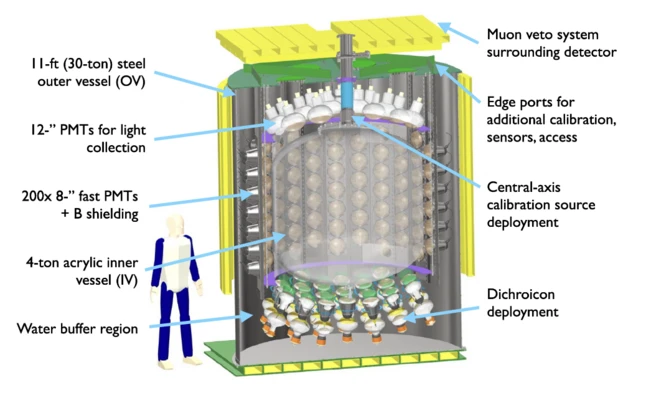EOS
EOS is a 20-tonne scintillation-based detector constructed at UC Berkeley. EOS provides an integrated test-bed for advanced R&D towards hybrid neutrino detectors, such as THEIA.
EOS consists of an acrylic vessel within a larger stainless steel tank (see Fig 1). The acrylic vessel is currently filled with water-based liquid scintillator (WbLS) and the steel tank with highly-pure water. Surrounding the acrylic vessel 204 8-inch R14688-100 high quantum efficiency, fast-timing photomultiplier tubes (PMTs) are located. Additionally, 24 R11780 12-inch PMTs are positioned at the top of the detector in order to further increase the coverage.

The current data-taking campaign includes extensive testing with radioactive sources and cosmic radiation. Using these deployed sources, we will verify a detailed optical model of the WbLS (which is used to extrapolate to ktonne scale detectors, such as THEIA), and test advanced reconstruction algorithms designed to use both the Cherenkov and scintillation photons to reconstruct event position, energy, and direction.
EOS provides a test-bed for many emerging technologies. EOS can change the hybrid target material within the acrylic vessel to test different novel materials at a large-scale. Additionally, EOS will test fast-timing and novel photodetectors, including a planned deployment of several dichroicons, likely positioned at the bottom of the detector, which provide spectral sorting of the short- and long- wavelength photons in order to separate the Cherenkov and scintillation components of the emitted light. Overall, EOS plans to enable a broad, world-leading physics and nonproliferation programs.
Contact
For collaboration, thesis opportunities, or further inquiries, please contact:
Dr. rer. nat. Hans Steiger
- Tel.: +49 (89) 289 - 51320
- hans.steiger@tum.de